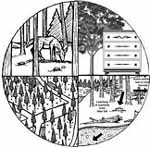Module 3: Thinning for Value
 How the public views our forest is different than it was 50 or even 20 years ago. Forest commodities like clean water, carbon storage, and biodiversity were not the focus of conversation at the local sawmill.
How the public views our forest is different than it was 50 or even 20 years ago. Forest commodities like clean water, carbon storage, and biodiversity were not the focus of conversation at the local sawmill.
We now understand the benefits of a healthy, diverse ecosystem that goes beyond providing a good quality of life. What we do today on our woodlot will provide for a healthy forest and economy.
Thinning is the felling or removal of selected trees in a stand to improve the quality of the remaining stand. For the saw miller, it may be higher quality logs. For the hunter, it may result in more trees suitable as browse for ruffed grouse. For many people, larger trees left after thinning creates a better looking forest. This improvement may be more valuable to the landowner than the increased revenues generated by higher value timber.
Thinning a forest offers many benefits:
- foot access can be greatly improved and more light can penetrate the canopy;
- future thinning and harvesting costs are reduced;
- economically, it increases growth of the remaining crop trees. When poor quality trees are removed, the remaining trees get more space, nutrients, sunlight and water.
- in addition, thinning helps recover wood volume from trees that would normally die from competition for light, nutrients or space. Recovering this wood allows the stand to produce more wood over its rotation.
In some cases, growth may result from more sunlight, whereas in other thinned areas nutrients and water may be limiting. In most cases, it's a combination of the two.
The forest cover types and regenerative abilities of the Acadian forest are well suited for thinning or tending activities.
The ideas presented in the following lessons should make your thinning operation a success. We begin with the process of natural thinning. The lessons learned from nature are transformed into prescriptions for thinning. This is how most modern silvicultural practices were developed.
